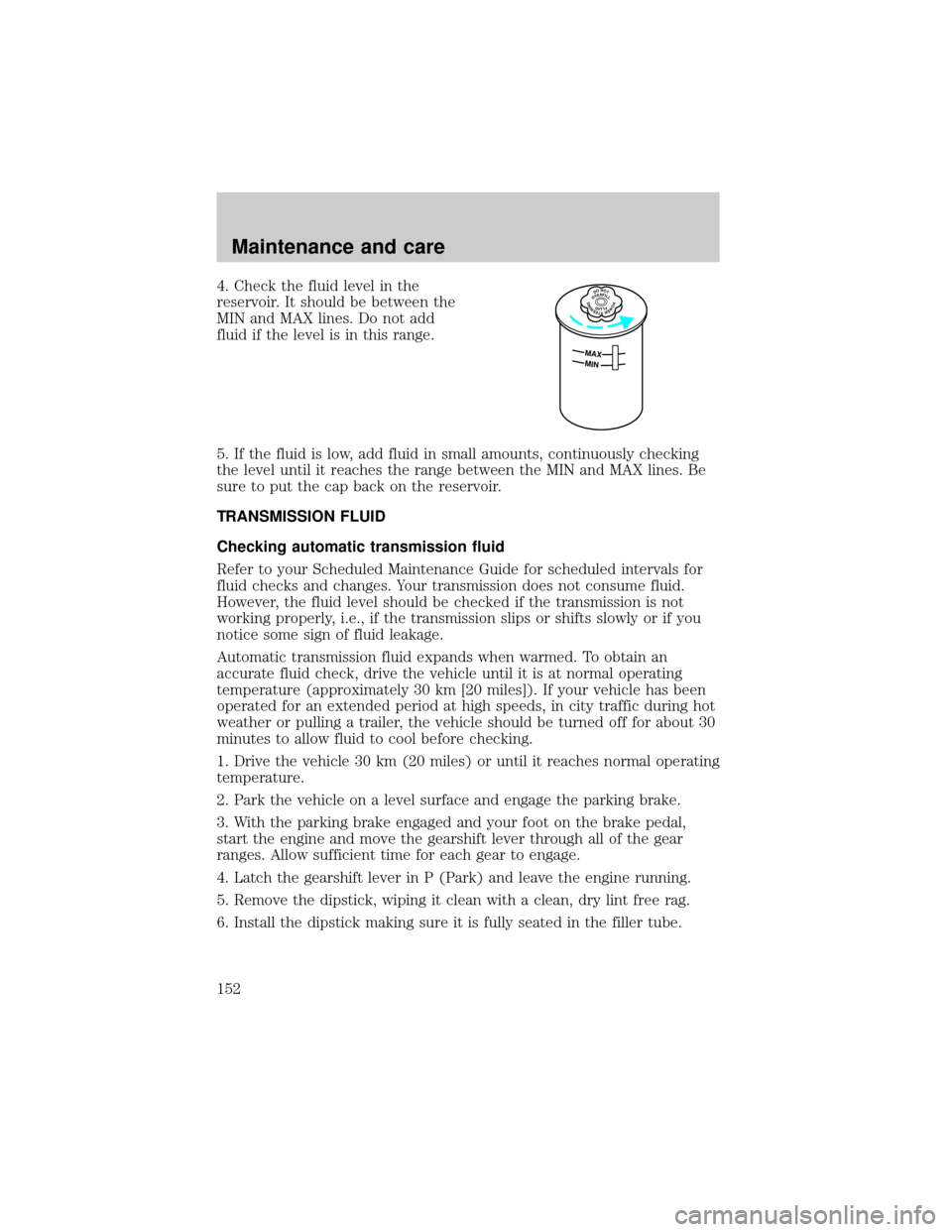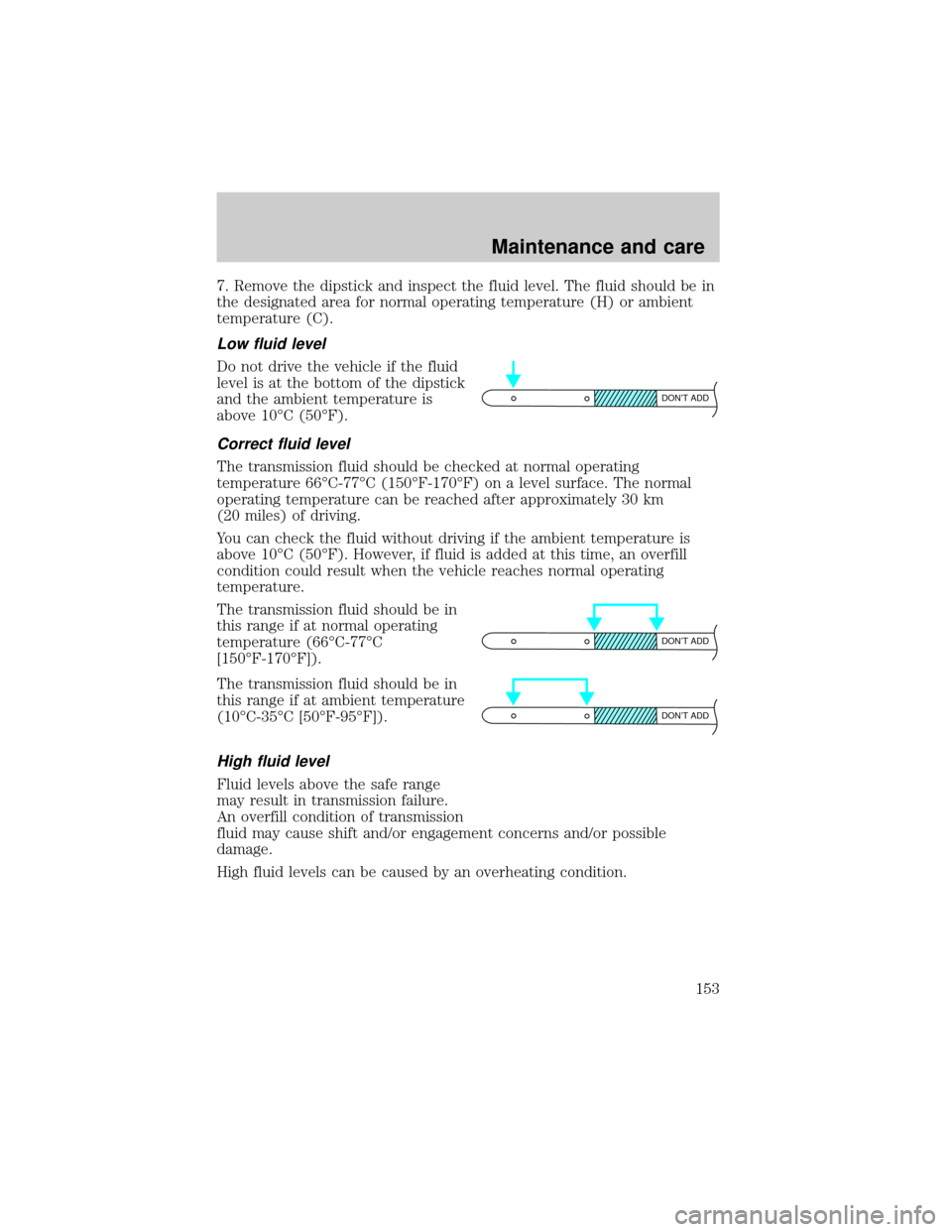1999 LINCOLN TOWN CAR check transmission fluid
[x] Cancel search: check transmission fluidPage 152 of 208

4. Check the fluid level in the
reservoir. It should be between the
MIN and MAX lines. Do not add
fluid if the level is in this range.
5. If the fluid is low, add fluid in small amounts, continuously checking
the level until it reaches the range between the MIN and MAX lines. Be
sure to put the cap back on the reservoir.
TRANSMISSION FLUID
Checking automatic transmission fluid
Refer to your Scheduled Maintenance Guide for scheduled intervals for
fluid checks and changes. Your transmission does not consume fluid.
However, the fluid level should be checked if the transmission is not
working properly, i.e., if the transmission slips or shifts slowly or if you
notice some sign of fluid leakage.
Automatic transmission fluid expands when warmed. To obtain an
accurate fluid check, drive the vehicle until it is at normal operating
temperature (approximately 30 km [20 miles]). If your vehicle has been
operated for an extended period at high speeds, in city traffic during hot
weather or pulling a trailer, the vehicle should be turned off for about 30
minutes to allow fluid to cool before checking.
1. Drive the vehicle 30 km (20 miles) or until it reaches normal operating
temperature.
2. Park the vehicle on a level surface and engage the parking brake.
3. With the parking brake engaged and your foot on the brake pedal,
start the engine and move the gearshift lever through all of the gear
ranges. Allow sufficient time for each gear to engage.
4. Latch the gearshift lever in P (Park) and leave the engine running.
5. Remove the dipstick, wiping it clean with a clean, dry lint free rag.
6. Install the dipstick making sure it is fully seated in the filler tube.DONOTOVERFILLPOWERSTEERINGFLUID
MAX
MIN
Maintenance and care
152
Page 153 of 208

7. Remove the dipstick and inspect the fluid level. The fluid should be in
the designated area for normal operating temperature (H) or ambient
temperature (C).
Low fluid level
Do not drive the vehicle if the fluid
level is at the bottom of the dipstick
and the ambient temperature is
above 10ÉC (50ÉF).
Correct fluid level
The transmission fluid should be checked at normal operating
temperature 66ÉC-77ÉC (150ÉF-170ÉF) on a level surface. The normal
operating temperature can be reached after approximately 30 km
(20 miles) of driving.
You can check the fluid without driving if the ambient temperature is
above 10ÉC (50ÉF). However, if fluid is added at this time, an overfill
condition could result when the vehicle reaches normal operating
temperature.
The transmission fluid should be in
this range if at normal operating
temperature (66ÉC-77ÉC
[150ÉF-170ÉF]).
The transmission fluid should be in
this range if at ambient temperature
(10ÉC-35ÉC [50ÉF-95ÉF]).
High fluid level
Fluid levels above the safe range
may result in transmission failure.
An overfill condition of transmission
fluid may cause shift and/or engagement concerns and/or possible
damage.
High fluid levels can be caused by an overheating condition.
DON’T ADD
DON’T ADD
DON’T ADD
Maintenance and care
153
Page 154 of 208

Adjusting automatic transmission fluid levels
Before adding any fluid, make sure the correct type is used. The type of
fluid used is normally indicated on the dipstick and/or dipstick handle
and also in theLubricant specificationssection in theCapacities and
specificationschapter.
Use of a non-approved automatic transmission fluid may cause
internal transmission component damage.
If necessary, add fluid in 250 mL (1/2 pint) increments through the filler
tube until the level is correct.
If an overfill occurs, excess fluid
should be removed by a qualified
technician.
An overfill condition of
transmission fluid may cause shift and/or engagement concerns
and/or possible damage.
BATTERY
Your vehicle is equipped with a
Motorcraft maintenance-free battery
which normally does not require
additional water during its life of
service.
However, for severe usage or in high temperature climates, check the
battery electrolyte level. Refer to the Scheduled Maintenance Guide for
the service interval schedules.
Keep the electrolyte level in each cell up to the ªlevel indicatorº.
Do not overfill the battery cells.
If the electrolyte level in the battery is low, you can add plain tap water
to the battery, as long as you do not use hard water (water with a high
mineral or alkali content). If possible, however, try to only fill the battery
cells with distilled water. If the battery needs water often, have the
charging system checked.
Maintenance and care
154
Page 200 of 208

Accessory delay ..........................67
Air bag supplemental
restraint system .....................91,95
and child safety seats ..............92
description ...........................91,95
disposal ......................................98
driver air bag .......................93,96
indicator light ...................7,94,97
operation ..............................93,96
passenger air bag ................93,96
Air cleaner filter .......................181
Air conditioning ..........................22
automatic temperature
control system ..........................22
Air suspension ...........................113
air leveling disabled warning,
message center .......................113
air ride switch off warning,
message center .......................113
check air ride system
warning, message center .......113
check air suspension warning,
message center .......................113
description ..............................113
warning light ...........................113
Anti-theft system ..............77,78,79
Automatic transmission
driving an automatic
overdrive .................................115
fluid, refill capacities ..............181
fluid, specification ..................184
Axle
lubricant specifications ..........184
refill capacities ........................181
traction lok ..............................117
Battery .......................................154
acid, treating emergencies .....154
jumping a disabled battery ....135
maintenance-free ....................154
replacement, specifications ...181
servicing ..................................154
Brakes ........................................109anti-lock ............................109,110
anti-lock brake system
(ABS) warning light ............8,110
brake warning light ....................8
fluid, checking and adding ....146
fluid, refill capacities ..............181
fluid, specifications ..........182,184
lubricant specifications ...182,184
shift interlock ..........................114
Break-in period .............................2
Capacities for refilling fluids ....181
CD changer .................................48
Child safety restraints ................98
child safety belts ......................98
child safety seats ......................99
Child safety seats ........................99
attaching with tether straps ..103
built-in child seat .....................99
in front seat ............................101
in rear seat ..............................101
tether anchorage hardware ...104
Cleaning your vehicle ...............176
engine compartment ..............178
exterior .............................177,180
exterior lamps .........................179
instrument panel ....................179
interior ..............................179,180
mirrors .....................................180
plastic parts ............................178
safety belts ..............................180
washing ....................................176
waxing .....................................177
wheels ......................................177
windows ..................................180
wiper blades ............................179
Clock ............................................52
Compass, electronic
calibration .................................17
set zone adjustment .................16
Controls ........................60,61,62,63
power seat ............................80,82
steering column ........................59
Index
200
Page 204 of 208

Transmission .............................114
fluid, checking and adding
(automatic) .............................152
fluid, refill capacities ..............181
lubricant specifications ..........184
Trunk
remote release .....................65,71
Turn signal ...............................8,54
Vehicle dimensions ...................184
Vehicle Identification Number
(VIN) ..........................................186
Vehicle loading ..........................118
Ventilating your vehicle ...........108Warning chimes ...........................12
Warning lights (see Lights) .........6
Washer fluid ..............................147
Water, Driving through .............122
Wheels
anti-theft lug nuts ..................134
Windows ......................................66
Windshield washer fluid and
wipers
checking and cleaning ............156
operation ...................................55
replacing wiper blades ...........157
Wrecker towing .........................140
Index
204